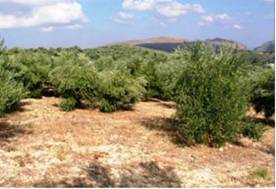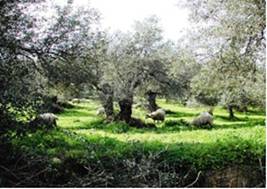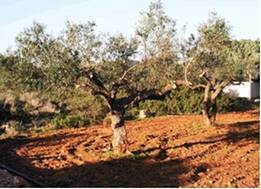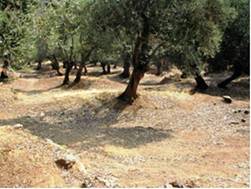Soil water conservation measures
Soil water conservation techniques may include the following: mulching, weed control, management of soil surface for maximum water infiltration and vapour adsorption, cultivation, etc. Weed control usually takes place by means of mechanical tillage or chemical sprays such as glyphosate, paraquat, etc., whereas mulching or grazing is alternatively applied in organic farming. Grazing is the removal of entire plants or parts of them by herbivores in order to feed themselves (Fig. 76).
Considering that the amount of rain occurring under arid or semi-arid climatic conditions are compared to the evapotranspiration rates during the dry period (May-October), water vapour adsorption becomes one of the most important sources of available water at least for the growing annual vegetation. Under such climatic conditions, soil physical characteristics such as surface mulching, and density of the growing plants greatly affect water vapour adsorption and soil water conservation. Management of the land by: (a) reducing the density of the growing vegetation and increasing the soil-atmosphere interface, (b) using surface mulches such as rock fragments or plant residues partially covering the soil surface, and (d) ploughing the soil for increasing macro porosity can beneficially and significantly affects water vapour adsorption and soil water conservation. The existing techniques on soil water conservation are recorded for each study site.


Fig 76. Examples of controlling weeds by using herbicides (left) and grazing (right)
Cultivation of the land using various tillage implements such as mouldboard, chisel, duck foot chisel, harrow, etc is considered as a management practice for conserving subsoil water However, ploughing the soils in hilly can cause severe problems of land degradation due to mechanical displacement of soils usually down slope (Fig. 77).


Fig. 77. Examples of water conservation by ploughing the soil (left) and keeping dry leaves as mulching on the soil surface (right)
Data for this indicator have been collected in 1051 field sites, corresponding to 12 study sites (Table 10). Soil water conservation measures have not defined in 58.2% of the study field sides, corresponding to all cases of the study sites Boteti Area-Botswana and Eskisehir-Turkey, and in some cases in the study sites of Djanybek-Russia, Secano Interior-Chile, Santiago Island-Cape Verde, Mamora Sehoul-Morocco, Guadalentin Basin Murcia-Spain, Zeuss Koutine-Tunisia, Cointzio Catchment-Mexico and Crete-Greece. Soil water conservation measures such as mulcting, weed control, etc., have been defined in 41.8% of the study field sites, corresponding to all cases of the study sites of Konya Karapinar plain-Turkey, Novij Saratov-Russia, and Eskisehir-Turkey, and in some cases of the study sites of Djanybek-Russia, Secano Interior-Chile, Santiago Island-Cape Verde, Guadalentin Basin Murcia-Spain, Zeuss Koutine-Tunisia, and Crete-Greece.